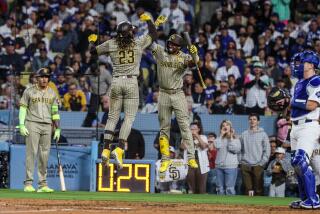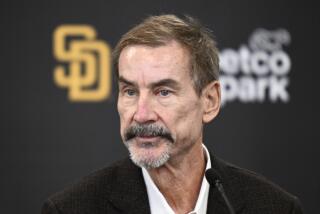Despite 2 No-Hitters, Reichle Will Proceed Slowly With Padres
- Share via
SAN DIEGO — Deep within the San Diego Padres’ farm system--you can’t get much deeper--lurks a pitcher who has thrown two no-hitters this season.
Darrin Reichle is a player whom Padre fans likely will be hearing quite a bit about in a few years. He’s 22 years old and, like many others his age, he’s trying to put together a career.
He boasts many skills that prospective employers would appreciate. He’s intelligent (Reichle speaks four languages, English, French, Spanish and German, the first three fluently). He’s a hard worker and hungry for success. And he’s a nice kid.
“We have 143 players in our organization, and I wouldn’t invite them all over to dinner,” said Tom Romenesko, the Padre director of player development. “I would invite Darrin Reichle over for dinner.”
But Reichle has another attribute the Padres, his current employers, appreciate as much as any of the above: a strong right arm.
Reichle, 6-feet 4-inches and just a year removed from St. Leo’s (Fla.) College (he left there after three years), is pitching for Charleston, S.C., of the Class A South Atlantic League. Before he was dropped from the rotation a month ago because of a sore arm, he had a 10-3 record and a 2.80 earned-run average. He’s a hard-thrower, consistently throwing in the 90-m.p.h. range, and has struck out 115 batters while walking just 58 in 104 innings this summer.
Then there are the two no-hitters, less than three weeks apart.
The first, which came after a 10-hour bus ride, was a nine-inning, 9-0 victory over Charleston (W. Va.) May 14.
The second came three turns later, on May 30, when he beat Fayetteville (N.C.) in the seven-inning second game of a doubleheader, 1-0.
For this, he was named the Topps minor league player of the month for May. And in a recent poll of South Atlantic League managers and pitching coaches, Reichle’s fastball, his most valuable tool, was voted the league’s best.
“Darrin is big-league material,” said Gary Lance, Charleston’s pitching coach. “From what he’s done already, and just watching him, you can’t doubt that he’s a rare breed.”
Said Romenesko: “In our organization, I don’t get excited one way or another about a player until he’s played a full year, and this is Darrin’s first full year. I’m not going to say he’s a definite major league prospect. But I say the same thing about Andy Benes (the Padres’ first pick in the June free-agent draft), and I’d say it about a fourth- or 24th-round draft choice. They’ve got to get out and play.
“However, I’m very encouraged, as is the entire organization, by his progress.”
But no player is a lock to make the majors, especially when he’s a pitcher with a slight case of tendinitis that has slowed his fastball and led to the bench. And it’s not the first time his arm has conked out in less than two years of professional ball.
Reichle was selected by the Padres in the fourth round of the June 1987 free agent draft. He went 4-1 with Spokane (Northwest League) last summer with a 2.96 ERA in 54 innings before being transferred to Reno (California League), where he was 0-3 with a 13.86 ERA in just 12 innings. His season ended prematurely because of what the Padres termed a “tired arm.”
“That’s true,” Reichle said. “In college, I was throwing every day for a year at a time.”
Therein lies a controversy. At St. Leo’s, he worked under former major leaguer Mike Marshall, who has his own ideas on pitching.
“(Reichle) came to us with a tired arm,” Romenesko told the Orlando Sentinel earlier this summer. “He had a regimentation posed by Mr. Marshall that was not realistic. All too often in college programs, they try to teach breaking ball, breaking ball, breaking ball. But Darrin’s got a good fastball, and that’s why he’s having such success. We’ve had him concentrate on three pitches instead of the seven or eight Marshall thought he had.”
Said Marshall, sarcastically: “I didn’t know I was getting him ready for pro ball. I was trying to coach him to pitch baseball in college. We started in September and went through April. If he wasn’t tired, then something would have been wrong. We were trying to win a championship.
“In five years of college coaching, I’ve never had a player miss a game because of an injury to his arm.
“When I got Darrin, he couldn’t throw a fastball within six feet of the plate, and he threw only 83 miles-per-hour. When he left, he was in the low-to-mid 90s, and he could throw the fastball for a strike, a screwball and a tough, hard breaking ball.”
Marshall, who pitched in the major leagues for 14 years and has a doctorate in exercise physiology, said he only teaches four pitches--two types of fastballs, a breaking ball and a “split-finger or hard screwball, whatever you want to call it.” He said he teaches the breaking pitch because, “you have to force a player to throw a non-fastball. If you don’t force him, he won’t learn to get the non-fastball over--and he’s never going to be a top-quality pitcher.”
Another one of Marshall’s theories is that every pitcher should throw from the mound every day.
During the season at St. Leo’s, the pitchers did this under Marshall’s supervision. In the offseason, they were required to do it at home.
“You have to know Mike Marshall to understand his philosophy and what he’s about,” Reichle said. “He’s a great person. I agreed with him for the most part, but the way he went about things . . . not every person is built the same way.”
Said Marshall: “God would be worried to know that. We may not all have the same enthusiasm, but we’re all built the same way. There’s nobody who can’t profit from work.”
All the pitchers on Marshall’s staff threw the same--every day.
“I couldn’t put up with that,” Reichle said. “In the offseason, I’d throw every two or three days. I’d skip a day and let my arm rest. I didn’t feel throwing every day was good for me.”
But during the season, Reichle said, he couldn’t escape.
“That might be where my tendinitis traces back to,” he said. “The shoulder seems to have gotten inflamed sooner this year.”
Said Romenesko: “It’s the way he threw every day. Our pitchers play long toss every day, but they don’t throw every day off the mound.”
Said Marshall: “My pitchers throw batting practice every day--basic fastball strikes. The main aspect of this is using proper mechanics. They rehearse the mechanics every day.”
Oddly, Marshall said that Reichle was one of his hardest-working pitchers.
“Darrin had trouble knowing when to stop,” Marshall said. “He’d throw four buckets of balls when I told him to throw two.”
Despite all the rhetoric, Reichle’s current sore arm isn’t a grave concern to the Padres.
“All young pitchers go through some stiffness and soreness,” Romenesko said. “We’re being real careful with him.
“When he came to us, he was overworked. We knew last year it would take at least a year to get him straightened out.”
So the team sent him to Padre minicamp last February in Yuma, Ariz., for an overhaul.
“We basically started from scratch--like we do with a lot of prospects,” Romenesko said. “We wanted to smooth out his mechanics. Because he’s 6-4, we had to get his coordination in line. Sometimes that takes three or four years, but Darrin adapted very quickly.”
Like many young pitchers who throw hard, Reichle’s control is less than perfect.
“He needs what I call better mound awareness,” Romenesko said. “It’s the experience factor--he doesn’t have command to do what his mind tells him on every pitch. Also, he’s got to work on his fielding.”
Still, Reichle is a legitimate prospect.
“He goes right after people, and you don’t teach people that,” Romenesko said. “The thing that’s most important to me is that Darrin Reichle misses a lot of bats. And when they do hit it, they don’t hit it very hard.”
Despite all of this, the Padres haven’t decided at what level Reichle will play next season. Reichle will determine that for himself in spring training.
“I’m a one-step-at-a-time guy as far as the organization is concerned,” Romenesko said. “I’m more concerned with the big picture than the little picture.
“Branch Rickey used to say, ‘You can never start them too low. You can always move them up. The minor leagues are like going to a college where they teach baseball. Double- and triple-A are my idea of graduate school. Guys in A ball are in undergraduate school. Right now, Darrin Reichle is doing well in undergraduate school.”
One thing is for sure: Padre fans shouldn’t expect to see Reichle at triple-A Las Vegas next summer. There are too many ahead of Reichle in the developmental stage, which suits him fine.
“If I have a good spring, maybe I can make double-A,” he said. “It would be good to start off there. The two things I don’t have are great control and concentration. A lot of times I’ll lose my concentration.
“I’m working on it, and it’s getting better. But that’s why I’ll be in minor league ball for the next couple of years.”
Reichle will not be playing winter baseball this year because he plans to attend the University of Central Florida. He’s a French major and hopes to finish his last semester this winter.
More to Read
Go beyond the scoreboard
Get the latest on L.A.'s teams in the daily Sports Report newsletter.
You may occasionally receive promotional content from the Los Angeles Times.










